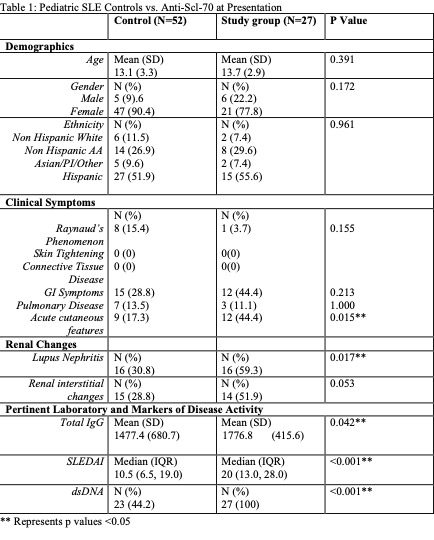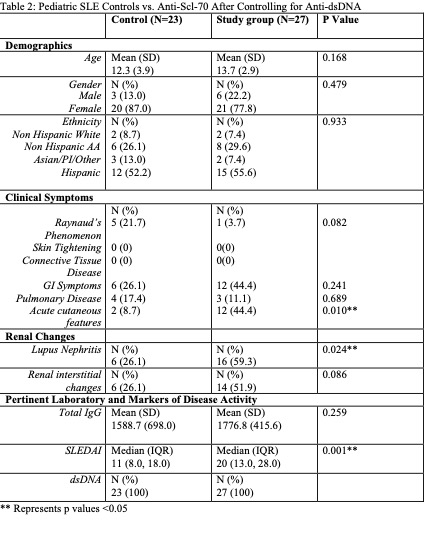Session Information
Session Type: Poster Session B
Session Time: 5:00PM-6:00PM
Background/Purpose: Production of autoantibodies is a hallmark of SLE, with ANAs as a required diagnostic feature and anti-dsDNA and anti-Smith antibodies being disease-specific. Anti-Scl-70 antibodies are clinically and prognostically associated with SSc, a disease characterized by cutaneous and visceral fibrosis and microvascular damage. The most common symptoms of SSc include Raynaud’s phenomenon, skin thickening, telangiectasias, and pulmonary, gastrointestinal, and renal disease. Adult studies have demonstrated an increased risk for pulmonary hypertension and kidney disease in SLE patients with anti-Scl-70 compared to those without. This study aims to determine the significance of anti-Scl-70 in pediatric SLE patients.
Methods: We performed a retrospective review of the electronic medical records of patients diagnosed with SLE, as per SLICC and EULAR/ACR classification criteria, at Texas Children’s Hospital between 2018 and 2021. Twenty-seven had positive anti-Scl-70 as reported by the University of Missouri lab. The data collected included clinical and diagnostic features at presentation, 6 months, and 12 months. Patients with anti-Scl-70 were compared to patients without anti-Scl-70. Characteristics were summarized by group and compared using an independent t-test, Wilcoxon rank-sum test, Chi-squared test, or Fisher’s exact test, as appropriate.
Results: Twenty-seven patients with anti-Scl-70 were analyzed against 52 patients without. The two groups were of similar demographics (Table 1). Study patients were more likely to have anti-dsDNA and were noted to have higher SLEDAI scores and IgG levels at diagnosis. These patients were noted to have a higher prevalence of lupus nephritis and acute cutaneous features, such as malar rash and photosensitivity.
There was no significant difference in Raynaud’s phenomenon, skin tightening, pulmonary disease, or gastrointestinal symptoms. When controlling for anti-dsDNA, as shown in Table 2, SLEDAI scores, IgG levels, lupus nephritis, and acute cutaneous features continued to be significantly higher in anti-Scl-70 patients compared to controls.
There was no significant difference in IgG levels or prevalence of lupus nephritis between the two groups at 6-month and 12-month visits. Acute cutaneous features were more prevalent in anti-Scl-70 patients at the 6-month visit (p = 0.039) but were no longer significant at subsequent intervals. SLEDAI scores were higher at the 12-month visit (p = 0.026) in study subjects but demonstrated no difference at the 6-month visit.
Conclusion: This study showed associations between anti-Scl-70 and higher SLEDAI scores, higher IgG levels, lupus nephritis, and acute cutaneous features in pediatric SLE patients at diagnosis. These higher SLEDAI scores and IgG levels may suggest more active disease. After controlling for anti-dsDNA, there was no change in the relationship between anti-Scl-70 positivity and the above variables. Thus, the presence of dsDNA in anti-Scl-70 positive SLE patients cannot fully explain the relationships demonstrated in this study. Anti-Scl-70 in pediatric SLE patients may predict specific disease presentations and outcomes at 6-month and 12-month visits.
To cite this abstract in AMA style:
Janysek D, Pina Y, Guffey D, De Guzman M. Clinical Significance of Anti-Scl-70 Antibodies in Pediatric Lupus Patients: A Single Center Cohort [abstract]. Arthritis Rheumatol. 2023; 75 (suppl 4). https://acrabstracts.org/abstract/clinical-significance-of-anti-scl-70-antibodies-in-pediatric-lupus-patients-a-single-center-cohort/. Accessed .« Back to 2023 Pediatric Rheumatology Symposium
ACR Meeting Abstracts - https://acrabstracts.org/abstract/clinical-significance-of-anti-scl-70-antibodies-in-pediatric-lupus-patients-a-single-center-cohort/


